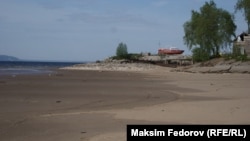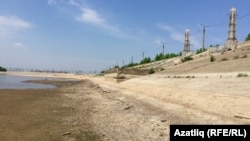In the central Russian city of Ulyanovsk, bathers at a popular municipal beach must traipse more than 200 meters to reach the waters of the Kuibyshev Reservoir.
Near Kazan, the capital of Russia's Republic of Tatarstan, a pavement from the late tsarist period that was flooded when the Volga River was dammed in the 1950s has reemerged from the depths to become a popular promenade. YouTube videos show people with metal detectors searching for medieval treasures in the exposed silt.
Elsewhere in Tatarstan, people share images of local rivers showing muddy river bottoms speckled with stagnant puddles.
Alarmingly low water levels have been reported the length of the Volga system -- in Tver, Kostroma, Tolyatti, Saratov, Astrakhan, and more. In Tolyatti, the water dipped to 49 meters, according to the Baltic Height System the level that triggers shipping interruptions in the system.
Officials say the situation is unusual but not catastrophic. The reservoirs along the Volga are currently accumulating water and the Kuibyshev Reservoir was projected to be at 52.5 meters by the beginning of June, according to the Samara regional branch of the Forestry Ministry.
Others, however, are concerned that those responsible for managing the complex waterway have failed to adapt to changing circumstances. Although the snowfall in the Volga catchment this year was higher than average, the winter was also significantly warmer than usual.
"Over the last 20 years, the ground has frozen and the snow on top of it melts in the spring and flows into the Volga," says Sergei Simak, chairman of the Russian Green League. "Hydrologists expected this again this year, but the ground did not freeze and absorbed a large portion of the water. Actually, this is quite good for the soil. But because of the miscalculation by hydrologists, we now have this situation with the Volga."
'It Can't Be Good In Both Places'
Europe's longest river, the Volga wends some 3,520 kilometers from the Tver region in northwestern Russia to the Caspian Sea in the south, where it forms Europe's largest estuary below the city of Astrakhan. Its watershed -- 1.35 million square kilometers -- covers almost all of European Russia and includes 11 of the country's 20 largest cities. Spanned by 13 hydroelectric stations, the river today is a cascade of reservoirs. The system is also crucial to agriculture, forestry, and fisheries, in addition to being a major transportation route.
By the time the federal Water Resources Agency ordered the spillways closed on May 14, they had been open for 23 days.
Aleksandr Epifanov, a specialist on the middle Volga region with the Water Resources Agency, tells RFE/RL that a decision was made to release water to the lower Volga region to facilitate spawning in the country's caviar-producing region.
"This is done every year in late April and early May, but this year the release of water was not offset by an influx of meltwater," Epifanov says. "This is only happening now, when the release of water is minimal and is more than offset by inflows."
Epifanov concedes that the fisheries of the middle Volga have been, to some extent, sacrificed in the interest of the more important fisheries in the south. "This is true," he says, "but it was a forced measure.... No one has come up with a system where it can be both good here and great there. If we create good conditions for fish [in the middle Volga], then the losses in the lower Volga would be enormous, increased at least three times over."
Kirill Lunin, an expert with the Ulyanovsk regional Organization of Hunters and Fishermen, tells RFE/RL that middle Volga species such as pike, bream, and carp could be devastated because they have already laid their eggs in Volga tributaries that are now drying up.
"The low water came right at the spawning time," he says, "so the next generation will be smaller than normal and this will affect the overall population." He says more than 3,000 spawning areas in the central Volga catchment have been affected.
In 2010, when Volga water levels were also dangerously low due to a major drought, the city of Tolyatti experienced increased levels of manganese in its drinking water, about half of which comes from the river.
Ecologist Simak says the current situation will not be a disaster, but cities like Tolyatti will have to pay more to clean their drinking water and the public could see negative effects of increased chlorination needed to kill off algae blooms. "The quality of the water will be worse," he says.
'Get Used To It'
Yevgeny Burdin, an engineer who has written several books on the history of the hydroelectric development of the Volga, notes that the low-water situation is aggravated because all the Volga dams are controlled by the Rusgidro state corporation, which is controlled by the federal government.
"The profits from the generators go to Moscow and the country's economic elite," Burdin tells RFE/RL. "And they don't care about anything except the profit from generating and selling electricity. The fact that we don't have any fish or clean drinking water is a result of this imperial mentality."
Biologist Mikhail Shustov, who studied the ecology of the Volga Basin at the Russian Academy of Sciences, says the low-water situation this year could be a harbinger of things to come. And he is skeptical of the government's ability to adapt to changing circumstances.
"Unfortunately, many of the programs the government has announced in the past have turned out to be ineffective," he said in a recent interview with the Ulyanovsk edition of the popular Argumenty i fakty newspaper. "If the current program for improving the Volga Basin meets the same fate, then we will have to get used to seeing the Volga like it is today and we should prepare ourselves for even worse scenarios."











